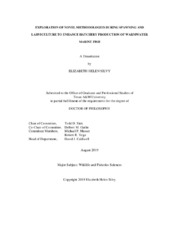| dc.description.abstract | Aquaculture is vital for supporting the United States (U.S.) seafood production and to meet the growing demand for seafood and lessen reliance on foreign imports. The U.S. is turning to novel technologies and refining methodologies in aquaculture production to meet these demands. Especially, there is a clear lack of warm-water, marine-culture facilities in the U.S. To address the needs of the growing aquaculture industry, I conducted four separate research trials. The first evaluated the use of a sucrose based time-release excipient in hopes the excipient would have the potential to replace large and invasive hormone implants that are currently used for spawning cobia (Rachycentron canadum). The primary objective was to determine if slow-release, cellulose-based spawning peptide implants containing sGnRHa combined with an intramuscular sGnRHa peptide and domperidone injection would synchronize and induce ovulation in captive, sexuallymature female cobia. The second study was a clinical trial to make observations of gross pathology of a novel excipient on red drum (Sciaenops ocellatus). The primary objective was to assess the safety and conversely any adverse effects of a sucrose-based excipient when injected into the dorsal musculature or intra-coelomic cavity of red drum. The third was to evaluate methodologies to create gynogenetic female clones of southern flounder (Paralichthys lethostigma). The primary objective was to determine which shock treatment (pressure or cold shock) would induce diploid genesis and produce more viable offspring in southern flounder. The final study evaluated the creation of a livefoods-harvesting system for spotted seatrout (Cynoscion nebulosus) larvae. The primary objective was to investigate the feasibility of automated live-food-harvest systems in marine larviculture. Results showed the use of sGnRHa combined with an intramuscular sGnRHa peptide and domperidone injection to synchronize and induce ovulation in cobia produced eggs within 120 hours after injection. However, 12 hours after egg production, eggs were inspected under a microscope and found to be malformed and displayed signs of fungal infection and no larvae were produced. The induction of ovulation through hormone injection in sexually mature adult cobia was successful.
Results from the clinical trial to make observations of gross pathology of a novel excipient on red drum found survival after treatment was 100% with no signs of primary or secondary bacterial infections. Only 5 of the 20 fish injected showed minor effects of the injections. While this was the first clinical trial using this sucrose-based excipient, it has the potential to replace commonly used hormone implants or injections.
Results to create gynogenetic female clones of southern flounder found a significant (F = 9.93, df = 2, P = <0.0001) creating gynogenetic clones of the female that can then be sex reversed to produce a broodstock consisting of genetically female fish that are phenotypically male.
Results from the evaluation of a live-foods-harvesting system for spotted seatrout larvae indicated the mean number of fish surviving in the control tanks, the enrichedrotifer-monoculture tanks and live-foods-harvesting-system tanks was not significantly (F = 3.59, df = 2, P = 0.071) different. However, the mean size (cm) of control larvae were significantly (F = 5.99, df = 2, P = 0.004) larger than larvae for the enrichedrotifer-monoculture, while larvae in the live-foods-harvesting-system were intermediate in size and not significantly different from any other group. As this was an original system, issues such as mechanical problems were to be expected and further testing with the live-foods-harvesting system may prove its efficiency at replacing hand-cultured live-foods diets for larval marine fish. In conclusion, all four studies contributed to expanding technologies and methodologies during spawning and larviculture phases of hatchery production. These technologies and methodologies have application to many fish species. | en |


